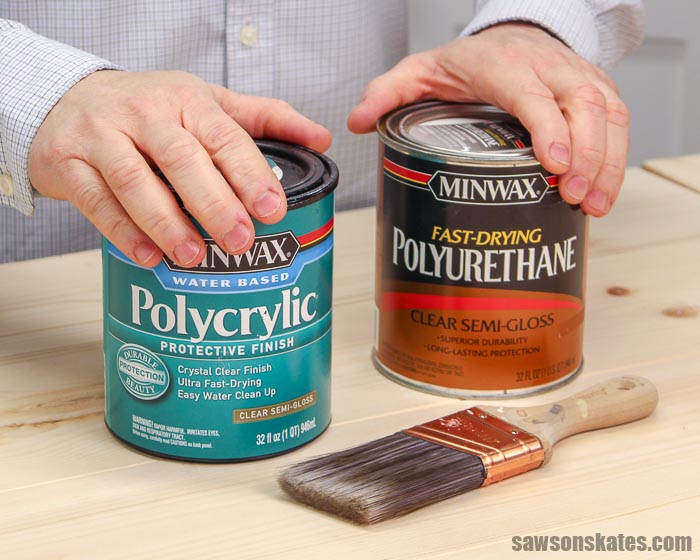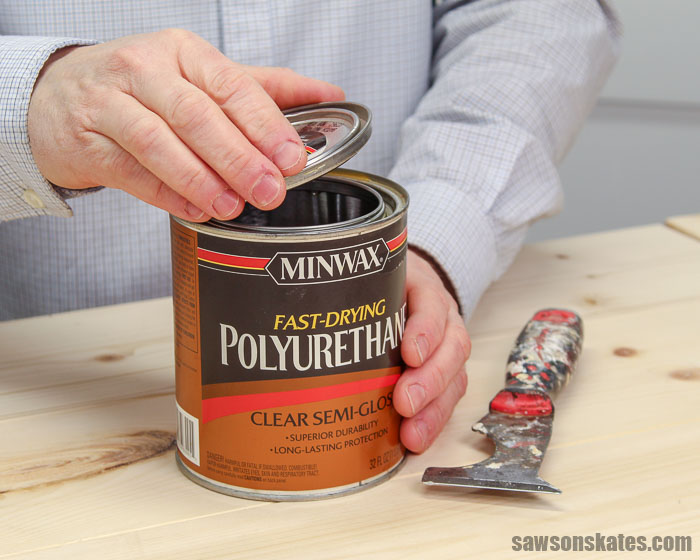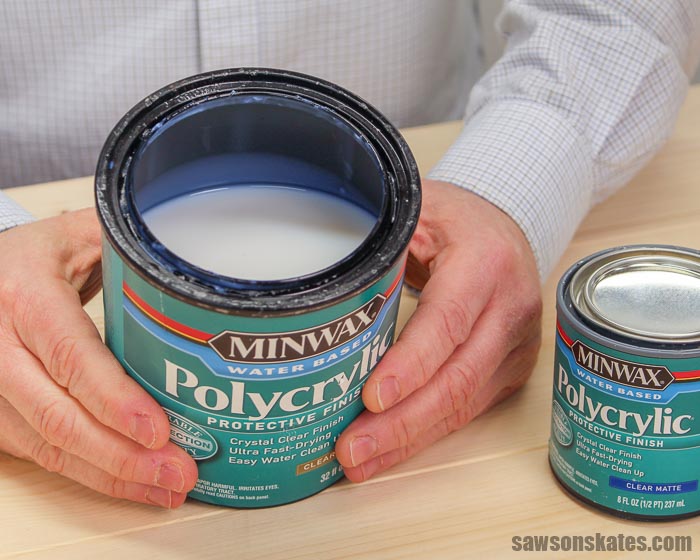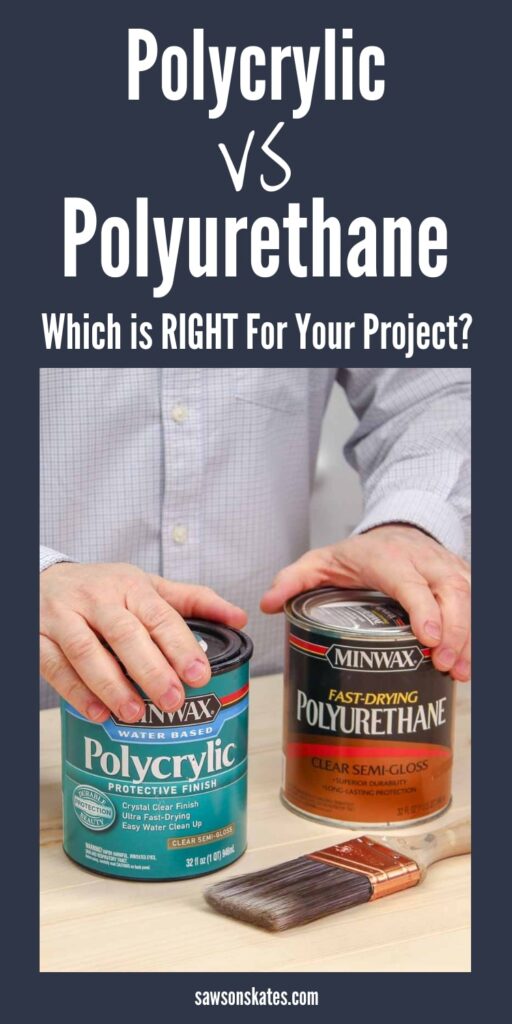Polycrylic vs Polyurethane (Are They The Same?)
Polycrylic and polyurethane sound similar but are not the same. It’s important to know the differences, so you choose the right one for your wood projects.

Are Polycrylic and Polyurethane the Same Thing?
Polycrylic and polyurethane have similar names and are used for the same purpose. Both are protective top coats used for wood projects. They both seal and add a shine to wood but there are pros and cons for each product.
Is polyurethane more durable than Polycrylic? Which one is more resistant to heat and moisture? Which one is easier to apply? Which one is easier to clean up? It’s important to know the differences so you can choose the right one for your wood projects.
This tutorial contains affiliate links to supplies and tools. Purchases made using these links help support the Saws on Skates website and allows me to share more projects and tips with you. There is no cost to you for using these links. Visit my site policies for more information.
Before we get into Polycrylic vs polyurethane, be sure to click the subscribe button at the bottom of this page to sign up for my FREE weekly newsletter loaded with helpful pocket hole tricks, space-saving workshop ideas, clever DIY tips and more!
Table of Contents
- Why Should I Use Polycrylic or Polyurethane?
- What is Polyurethane?
- What is Polycrylic?
- Where to Use?
- How to Apply?
- How to Clean Up?
- What is the Color?
- What Sheens are Available?
- Which is More Durable?
- Which is More Dangerous?
- Polycrylic vs Polyurethane Comparison Chart
- Where to Buy?
- Frequently Asked Questions
Why Should I Use Polycrylic or Polyurethane?
Polycrylic and polyurethane are both protective top coats. A protective top coat prevents dirt, dust, water, oil, grease, etc. from penetrating into wood surfaces. A top coat also protects against normal wear and tear like scratches. The top coat seals and adds a shine to wood.
More ways to protect wood projects:
Back to Table of ContentsWhat Is Polyurethane?
Wikipedia defines polyurethane as a polymer. But there’s more to it. I’ve heard polyurethane called “liquid plastic.” I’ll be honest with you, I don’t understand all of this “sceintific-y” stuff like organic units, carbamate, alternating copolymers, etc.
What I do understand, is when Wikipedia says polyurethane finishes for wood are “typically hard, abrasion-resistant, and durable coatings”. Which is another way of saying polyurethane is a protective top coat for wood.
There are two types of polyurethane wood finishes. There are oil-based polyurethanes and water-based polyurethanes.
Oil-Based Polyurethane
Oil-based polyurethane is durable. We’ll often see it used to protect hardwood floors and furniture projects that will see a lot of abuse.
It’s resistant to water which makes it a great choice for protecting wood projects that will come in contact with moisture like kitchen cabinets and bathroom vanities. It’s also resistant to oil, grease, and other solvents.
Polyurethane is resistant to high temperatures which makes it a good choice for protecting kitchen tables and dining tables that come into contact with hot pans and dishes.
When we open a can of oil-based polyurethane we’ll notice it has a strong odor. Oil-based poly is loaded with volatile organic compounds or VOCs. Tox Town (U.S. National Library of Medicine) says “Volatile organic compounds (VOCs) are compounds that easily become vapors or gases.”
Short-term exposure to VOCs can cause eye irritation, headaches, dizziness, and more. Long-term exposure can cause damage to the liver, kidneys and the central nervous system. It can also cause cancer.
All of this to say, it’s important that we work with oil-based polyurethane in a well-ventilated area and use a respirator that’s designed to block out VOCs.

When we read the instructions on a can of poly we will notice a caution that reads “contents are combustible”. Again, it’s important to work in a well-ventilated area away from heat and open flames. It’s also important to properly dispose of tools, rags, etc. so they don’t combust.
It takes a while for oil-based polyurethane to dry. The temperature and humidity levels can affect the drying times. This fast-drying polyurethane can be recoated after 3-4 hours. It needs another 24 hours before it’s ready for “light use”.
There’s one last thing I want to mention about oil-based polyurethane. A while back, I attended a Woodworking Shows event and sat in on the “Choosing the Right Finish” class presented by Jim Heavey. The Woodworking Shows website says “Jim has been a woodworker for over 30 years and a contributing craftsman and educator for WOOD Magazine since 1997.”
Jim said the one big difference between oil-based poly and water-based poly or even Polycrylic is that oil-based polyurethane “adds a depth” to wood. In other words, oil-based poly enhances the wood grain whereas a water-based product does not. Just something to keep in mind if you’re trying to make the wood grain pop.
Water-Based Polyurethane
Water-based polyurethane is durable, dries faster, and contains less volatile organic compounds (VOCs) than oil-based poly. But it’s not as heat resistant or water-resistant. It also does not enhance the wood grain like oil-based poly.
Is There an Exterior Polyurethane?
In the “Choosing the Right Finish” class, Jim advised avoiding polyurethane for outdoor projects. Instead, he suggested opting for spar urethane, which has a “sunscreen” that blocks some of the UV light from the sun. It also has an elasticity component that expands and contracts without cracking.
Related: Spar Urethane vs Polyurethane (Differences + Which to Use)
Back to Table of ContentsWhat is Polycrylic?
Polycrylic is a water-based protective finish made by Minwax. It’s available in liquid and spray aerosol cans. It dries quickly, usually in about 2 hours. It’s ready for light handling after about three hours but needs at least 24 hours before it’s ready for “normal use”. We need to be careful during this time because it can scratch or dent before it’s fully cured.
Polycrylic doesn’t resist heat and moisture as well as oil-based polyurethane. It also doesn’t enhance the wood grain like oil-based poly.

We’ll notice a couple of things when we open a Polycrylic container. First, the product is a milky white color. Don’t worry. This product dries crystal clear.
The next thing we’ll notice is that it doesn’t have a strong odor like polyurethane. It contains less harmful VOCs than poly. I’ve heard some people say that this means we don’t wear a respirator when we apply Polycrylic. I would argue the opposite. I think it’s always important to wear personal protective equipment (PPE) and I wear a respirator when I apply Polycrylic.
The last thing we’ll notice is the consistency of Polycrylic is runny. This runny consistency can make it difficult to apply on vertical surfaces. In other words, we need to watch for drips when it’s applied to vertical surfaces like the sides of bookcases or doors.
Back to Table of ContentsWhere to Use It?
Polyurethane and Polycrylic can be used on any number of wood surfaces; however, each is better suited for different applications.
What is Polyurethane Used For?
Oil-based polyurethane is best for surfaces that require a great deal of protection and durability, such as wooden floors, doors, trim, kitchen tables, dining tables, cabinets, and more. For example, I used an oil-based poly to seal this wall-mounted wine bar.
Although not as durable as oil-based polyurethane, water-based poly is ideal for projects such as desks, side tables, and bookcases that don’t require as much protection.
The oil-based version also enhances the wood grain, making it a great choice for pieces with beautiful grain patterns.
What is Polycrylic Used For?
Polycrylic doesn’t provide the same level of protection as polyurethane and doesn’t enhance the grain like oil-based polyurethane. However, it’s an excellent choice for surfaces where durability against moisture and heat isn’t a concern, such as desks, side tables, bookcases, picture frames, home decor projects, and more.
The consistency of Polycrylic is runny, so it works best for horizontal surfaces.
It also dries quickly, making it difficult to get an even finish on large projects. I’ve used Polycrylic on small projects like this DIY cupcake stand and this DIY spice rack. So far, I’ve been pleased with the results.
Back to Table of ContentsHow to Apply?
Water-based products like water-based polyurethane and Polycrylic raise the grain of raw wood (wood that has not been stained). In other words, the wood is no longer smooth after the finish is applied.
Related: What’s the Best Sander for Furniture? (Here’s the Answer)
One way to prevent this from happening is to prepare the wood before applying the water-based finish. Dip a rag in water and wipe it on the surface of the wood. When the wood is dry, lightly sand with 220 grit sandpaper. Remove the sanding dust with a ShopVac and a tack cloth, then apply the water-based top coat.
The first step to preparing any project for a top coat is to sand the surface of the wood smooth.
Related: 11 Secrets for Sanding Wood Projects Like a Pro
Polyurethane
Polyurethane needs to be applied in a well-ventilated area. It’s also important that the area is dust-free. Polyurethane takes awhile to dry. This means there’s a long time that dust could land on the project and dry in the finish. Any dust specs will need to be sanded out before applying the next coat.
Always use a respirator that’s designed to block out VOCs when applying poly.
Polyurethane can be brushed, sprayed, or wiped on. Do not shake liquid polyurethane. Shaking will introduce bubbles. Those bubbles will end up on the brush and dry on the surface of the wood. Any bubbles will need to be sanded out before applying the next coat.
Related: How to Spray Polyurethane
Three coats of poly are usually needed to give projects the proper amount of protection. The first coat or base coat of polyurethane should be thinned. A base coat is two (2) parts of polyurethane to one (1) part of paint thinner. The second and third coats are applied at full strength.
Each coat is allowed to dry. Polyurethane doesn’t like to stick to itself. The surface needs to be roughed up to give the next coat something to bite into. 220 grit sandpaper is used between each coat and the sanding dust is removed with a ShopVac and a tack cloth.
Related: What is a Tack Cloth (+ What I Use Instead)
Polycrylic
Polycrylic can be brushed, or sprayed. Three coats are recommended.
Related: How to Apply Polycrylic (Without Streaks or Brush Strokes)
Polycrylic is runny. This runny consistency can make it difficult to apply on vertical surfaces. It’s best to apply thin coats and brush out any drips. It also dries quickly so it can be tricky to get a smooth finish on large areas.

Unlike polyurethane, Polycrylic does not need a base coat. Apply and allow each coat to dry for about two hours. Lightly sand with 220 grit sandpaper between each coat and remove the sanding dust with a ShopVac and a tack cloth.
TIP: Don’t use steel wool to sand between coats when using water-based products like Polycrylic. Water can cause steel wool to rust. If any of the steel wool is left behind it could cause a stain in the finish.
Which is Easier to Apply?
This is a bit of a toss-up. Polyurethane and Polycrylic each can be tricky to apply.
When we apply polyurethane, we have to be careful not to introduce bubbles into the finish. Those bubbles will dry in the finish and need to be sanded out.
Polycrylic is difficult to apply on large projects because of the runny consistency and how quickly it dries.
That said, I think Polycrylic is easier to work with for smaller decor projects, and polyurethane is easier to work with for larger projects.
Back to Table of ContentsHow to Clean Up?
Oil-based polyurethane needs to be cleaned up with mineral spirits.
Water-based polyurethane and Polycrylic tools are cleaned up with soap and warm water.
Which is Easier to Clean Up?
Soap and warm water make water-based polyurethane and Polycrylic easier to clean up.
Back to Table of ContentsWhat Sheens are Available?
Sheen is the level of glossiness. A higher gloss level means more shine and the lower the gloss level means less of a shine.
Gloss (most glossy) → Semi-Gloss → Satin → Matte (least glossy)
Polyurethane is available in satin, gloss, and high gloss finishes.
Polycrylic is available in satin, gloss, and a high gloss finish It’s also available in a matte finish. I’ve been using the matte-finish many of my recent projects. I think the matte finish pairs well with chalky-paint finishes.
Back to Table of ContentsWhat is the Color?
Oil-based Polyurethane has a yellowish tint and tends to yellow with age. This adds a warm glow to dark woods but can make light woods look a little dingy.
Water-based polyurethane dries clear.
Polycrylic goes on milky white but dries crystal clear, which is ideal for light-colored woods such as maple, pine, birch, and ash. Remember to apply thin, even coats. Applying too much can give dark-colored projects a milky look.
Which is More Durable?
All of these products are strong, but the oil-based polyurethane is the strongest. Oil-based poly is the one to use for projects that see a lot of wear and tear like floors and dining tables.
Back to Table of ContentsWhich is More Dangerous?
Oil-based polyurethane is more dangerous to work with. It’s combustible, has a strong odor, and is loaded with VOCs. It should only be used in a well-ventilated area with a respirator.
Polycrylic is not combustible, the odor is not as strong, and has lower VOCs (but I would still wear a respirator).
Polycrylic vs Polyurethane Comparison Chart
| Polycrylic | Oil-Based Polyurethane | Water-Based Polyurethane | |
|---|---|---|---|
| Heat | Good | Best | Better |
| Moisture | Good | Best | Better |
| Light Woods | Best | Gives a yellow tint | Best |
| Dark Woods | Can look milky with heavy coats | Best | Better |
| Floors | Not Recommended | Best | Better |
| Large Furniture | Can be difficult to get a smooth finish | Best | Best |
| Vertical Surfaces | Can be difficult to apply – watch for drips | Best | Best |
| Volatile Organic Compounds (VOCs) | ✔ | ✔ ✔ ✔ | ✔ ✔ |
| Time to Dry | Quickest | Slowest | Slow |
| Clean Up | Soap and Water | Mineral Spirits | Soap and Water |
Where to Buy
Polycrylic and polyurethane are available at home improvement stores and hardware stores. You can also buy online and have it sent to your home. Here are some popular options.
Back to Table of ContentsFrequently Asked Questions
Which is better, polyurethane or Polycrylic?
Deciding whether polyurethane or Polycyrlic is better depends on your project. Polyurethane is more durable and offers more protection for projects like floors, cabinets, and dining tables that may experience a lot of wear and tear or areas prone to heat and moisture.
Polycrylic doesn’t offer as much protection as polyurethane, so I primarily use it to seal lighter-duty projects that won’t be exposed to a lot of wear and tear, such as side tables, bookcases, wall art, and small accessories.
Is Polycrylic waterproof?
No, Polycrylic is not waterproof, although it does provide a certain degree of water resistance. Because it’s water-based, it doesn’t offer the same level of protection against moisture as oil-based alternatives like polyurethane and spar urethane.
Can Polycrylic be used outside?
No, Polycrylic is for indoor use only. For maximum protection against the elements, I recommend a product like spar urethane which is designed for outdoor use.
Does Polycrylic dry clear?
Yes, Polycrylic dries crystal clear. It goes on milky white but turns clear as it dries; however, dark woods may have a milky appearance if too much is applied. Be sure to apply thin, even coats for the best results.
Back to Table of ContentsFinal Thoughts
Polycrylic and polyurethane have similar names and are used for the same purpose. Both are protective top coats used for wood projects. They both seal and a shine to wood but there are pros and cons for each product.
Polycrylic and polyurethane can be used for many of the same projects. It’s good to have both on hand so you can use the best option for that particular project.
Thank you for stopping by. If you enjoyed this tutorial, would you please take a moment and pin it to Pinterest? I’d really appreciate it!


Thank you! This was very informative. I am a beginner and I could understand this!
Hi Warner – I’m glad this was helpful for you!
Thanks for your input on the proper finishes. I have used both types of finishes and recently refinished a wood front door using a water based polyurethane. The final product came out looking great.
Hi Gary – Thank you for stopping by. You’re welcome. Glad to hear your door project was a success.
I worked with both and thought they were used the same way. Now I know the difference. tks
Hi Barry – You’re welcome. I’m glad this was helpful for you.
I thought Polycrylic and Polyurethane were interchangeable. I never realized there was a difference. Thank you so much for the explanation as well as the quick at a glance chart.
Hi Steph – You’re welcome. I’m glad this was helpful for you.
Looking to protect an outdoor potting table kit that I’ll be assembling. Wondering which product is best. I’m assuming oil-based polyurethane is the choice. Is spraying a good option or is brushing it on best? Thanks.
Hi Ken – An outdoor oil-based polyurethane like an oil-based indoor/outdoor spar urethane would probably provide the most protection for a project like this. You could spray or brush the spar urethane. Brushed coats tend to be a little thicker than sprayed coats. In other words, you might need more coats of spray to equal the same protection as three brushed coats.
Great article on poly products, I learned a thing or 2 (or 10). How about a similar article discussing tung oil finishes, pure tung oil, and alternatives like waterlox.
I’m glad you enjoy this, Phil. That’s a great idea. Thank you for the suggestion!
Thank you for the explanation. They don’t explain the differences at the store and only hand you a can. Now, I know what I am looking for and why.
You’re welcome, Dee. I’m glad this was helpful.
I worked at a cabinet shop for a long time and I can verify that oil-based polyurethane is the way to go when it comes to finishing woods that see moisture. It just makes sense. Thanks for the article, helping a friend out with some reading materials.